Back to Journals » Clinical, Cosmetic and Investigational Dermatology » Volume 16
Survey of Hand Issues Encountered by Hairdressers and Hairdresser Related Professionals: From Epidemiological Data to Clinical Observational Survey Results
Authors Seité S , Le Dantec G , Demessant-Flavigny A , Kerob D
Received 1 September 2022
Accepted for publication 7 January 2023
Published 18 January 2023 Volume 2023:16 Pages 111—117
DOI https://doi.org/10.2147/CCID.S385681
Checked for plagiarism Yes
Review by Single anonymous peer review
Peer reviewer comments 2
Editor who approved publication: Dr Jeffrey Weinberg
Sophie Seité, Guénaëlle Le Dantec, Ann’Laure Demessant-Flavigny, Delphine Kerob
Medical Department, La Roche-Posay International, Levallois-Perret, France
Correspondence: Delphine Kerob, Cosmétique Active International, La Roche-Posay International, 62 quai Charles Pasqua, Levallois-Perret, 92300, France, Tel +33 6 62 40 22 52, Email [email protected]
Introduction: Hand eczema is frequent among hairdressers. The aim of this open survey was (i) to assess the prevalence and identify causing factors of hand issues encountered by hairdressers and (ii) to assess the benefit of a cosmetic skin care in clinical signs and symptoms through a clinical observational survey.
Methods: The survey was conducted among 391 hairdressers and hairdresser-related professionals, collecting information on frequency of daily procedures, frequency/type/severity of hand issues, and glove usage. The satisfaction provided by a dermocosmetic containing niacinamide, glycerin, shea butter and thermal spring water was examined in an evaluation visit one month after survey initiation.
Results: Investigated subjects were mostly hairdressers (73%). In their daily procedures, a majority (≥ 76%) always or often used shampoos, hair dyes, oxidants, bleachers, straighteners and perms. Overall, a majority (> 60%) of subjects always or often had hand irritation due to this use (except for straighteners). Most subjects (≥ 60%) reported using gloves in their procedures except with shampoos and straighteners. Among hand problems reported at survey initiation, the most intense was skin dryness, followed by redness, irritation, cracks, and fissures. Hand problems induced annoyance in their activities for most subjects (> 65%), leading to discontinuation of their professional activities for 28% subjects. The test dermocosmetic was applied for 1 week up to 1 month. At evaluation visit (1 month), the intensity of all hand signs and symptoms was decreased compared to initiation visit. In addition, 58.3% subjects reported return to professional activities instantly at evaluation visit versus 31.3% at initial visit. Most subjects (≥ 73%) were satisfied or very satisfied with the test cream properties.
Conclusion: Our survey confirms the impact of hand issues experienced by hairdresser professionals and highlights the need for gloves and for efficient hand care products.
Keywords: hand eczema, daily procedures, activity discontinuation, protective measures
Introduction
Hand eczema is an inflammatory skin condition that may be chronic in some patients, and its socioeconomic burden including societal costs, healthcare resource utilization, missed work time and job loss is considerable.1 A systematic review was performed to assess the association between occupations and incidence rate of hand eczema: the study found that hairdressers, nurses and metal workers had a high incidence of hand eczema.2 Indeed, hand eczema is frequent among hairdressers because of intense contacts with water and daily exposure to irritants and allergens. A systematic review of epidemiological studies published from 2000 to 2021 shows that the lifetime prevalence of hand eczema within hairdressers is up to 38.2%,3 while a recently published review estimated the lifetime prevalence of hand eczema in the general population at 14.5%,4 illustrating the increased risk of hairdressers to develop hand eczema.5,6
Patients and Methods
We conducted an open survey (single arm, observational survey) among 391 subjects from 4 countries (Italy, Poland, Slovenia, Croatia), either hairdressers or hairdresser-related professionals using hairdresser products:
- We collected in an initiation visit information regarding (1) daily procedures, (2) the frequency, type and severity of hand issues associated with these procedures such as dryness, redness, irritations, cracks, and fissures, and (3) usage of gloves during the procedures to protect from alteration of the skin barrier function due to repeated contact with water, shampoos and other hairdresser products (National Clinical Trial NCT05471934).
- We also evaluated the satisfaction provided by a dermocosmetic containing niacinamide (soothing agent also reinforcing the skin barrier), glycerin (for hydration), shea butter (nourishing agent also reinforcing the skin barrier) and thermal spring water (soothing agent) after up to one month of application (evaluation visit).
For participating countries, subjects were informed of their rights with regard to the processing of their personal data through an information leaflet translated into their native language, in accordance with the Regulation (EU) 2016/679 of the European Parliament and of the Council of 27 April 2016 on the protection of natural persons. Before answering the questionnaire, each respondent was informed of the nature of the survey, that their anonymity would be respected, and that collected information would not allow identification. Each respondent had to confirm in writing his or her agreement and non-opposition to answer the questionnaire. This operational survey was conducted between September and November 2019 and adhered to the principles of Good Clinical Practices and the declaration of Helsinki. According to local and European regulatory guidelines (Official Journal of EU of March 30th, 2010 paragraph 1.2.9, Scope [CELEX number: 52010XC0330(01) in https://eur-lex.europa.eu/oj/direct-access.html]), this type of trial testing marketed cosmetics did not require approval from local ethics committees.
Results
Of the 391 subjects included in the survey, 11 (2.8%) were excluded from all analyses due to the absence of evaluation visits. Among the investigated subjects, a majority (73.4%) were hairdressers, 13% had other functions such as colorists, nail technicians, beauticians, receptionists or sales representatives; 8.7% were managers or proprietors, and 4.9% were assistants or apprentices. The time spent in their respective functions was (mean±SD) 11.9±8.6 years (N = 328).
Epidemiological Data: Daily Procedures, Frequency and Type of Hand Issues, Usage of Gloves
The frequency of daily procedures was analyzed at initiation visit. Frequencies of associated hand irritations and of the usage of gloves were quantified (Table 1).
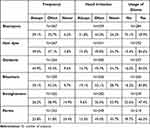 |
Table 1 Daily Procedures: Frequency, Hand Irritation, and Usage of Gloves |
Shampoos
If almost all (94.8%) subjects always or often used shampoos in their daily procedures, 65.8% always or often experienced hand irritation due to this use, and only 29.9% of them used gloves when applying shampoos.
Hair Dyes
A vast majority (96.1%) of subjects always or often used hair dyes, among which 65.2% always or often had hand irritation due to this use, despite widespread usage of gloves (84.6%).
Oxidants
90.4% subjects always or often used oxidants, among which 65.4% always or often experienced hand irritation due to this use, despite the usage of gloves for most of them (84%).
Bleachers
90.3% subjects always or often used bleachers, among which 71.2% always or often had hand irritation due to this use, despite the usage of gloves for most of them (83.8%).
Straighteners
85.1% subjects always or often used straighteners, among which 46.1% always or often had hand irritation due to this use, and only 47.4% of them used gloves during application.
Perms
75.6% of subjects always or often used perms, among which 64.3% always or often had hand irritation due to this use, despite the usage of gloves for most of them (60.3%).
Time Spent with Hands in Contact with Water
The time spent with hands in contact with water every day was more than 3 h for almost half of the subjects (46.6%), 1 to 3 h for 33.8%, 30 min to 1 h for 13.4%, and less than 30 min for 6.2% subjects.
Hand Problem Severity
Among hand problems described at initiation visit using a 0 (none) to 10 (very strong) intensity scale, “strong to very strong” skin signs and symptoms (intensity scores ≥8) were reported by 32.3% subjects for dryness (Table 2), 20.4% subjects for redness (Table 3), 21.6% subjects for irritation (Table 4), 22.9% for cracks (Table 5), and 10.7% subjects for fissures (Table 6). Conversely, “no to very light” skin signs and symptoms (intensity scores 0 to 1) were reported essentially for fissures (42.5% subjects, Table 6); these percentages decreased to 25.2% for cracks (Table 5), 18.2% for irritation (Table 4), 14.2% for redness (Table 3) and only 9.3% for dryness (Table 2).
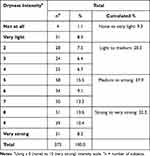 |
Table 2 Hand Problems Described at Initiation Visit: Dryness |
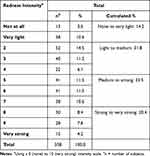 |
Table 3 Hand Problems Described at Initiation Visit: Redness |
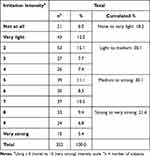 |
Table 4 Hand Problems Described at Initiation Visit: Irritation |
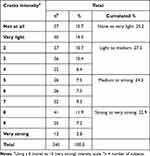 |
Table 5 Hand Problems Described at Initiation Visit: Cracks |
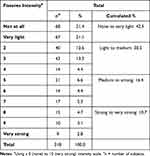 |
Table 6 Hand Problems Described at Initiation Visit: Fissures |
These hand problems induced annoyance in their activities for most subjects (always for 20.7%, sometimes for 45.5%). Even 28% subjects reported discontinuation of their professional activities due to the hand issues (data collected in Poland, Slovenia and Croatia), in line with the observation of missed work time (up to 57% subjects taking sick leave) reported by Armstrong et al in their review of the economic burden of hand eczema.1
Clinical Observational Survey Results: Efficacy and Satisfaction Provided by a Dermocosmetic Cream
A hand cream was reported to be used at least from time to time by 96% subjects, among which only 62.8% declared being satisfied or very satisfied by this use. This underlines the need for a more frequent use of suitable hand products with good cosmetic acceptability.
The efficacy and satisfaction of the niacinamide/glycerin/shea butter/thermal spring water test cream was examined after up to 1 month of application (evaluation visit). More than 90% of subjects had applied the product at least for 1 week (24.4% for 1–2 weeks, 25.7% for 2–3 weeks, 20.4% for 3–4 weeks, and 20.2% for 4 weeks). Overall, the subjects reported an improvement of all hand signs and symptoms (dryness, redness, irritations, cracks, fissures) compared to the initiation visit.
The time needed to resume professional activities after applying the test dermocosmetic was compared to that reported at initiation visit. Of note, almost twice as many subjects reported return to professional activities instantly at evaluation visit compared to initial visit (58.3% versus 31.3%, respectively).
For 79.4% subjects, the application of the test dermocosmetic allowed wearing the gloves comfortably. A large majority of the subjects (90.1%) would recommend this product to other colleagues. Most subjects were satisfied or very satisfied by the texture (74.1%), absorption time (73.8%), efficacy (79.7%), and long lasting effect (72.9%). Almost half of the subjects (49.6%) were more satisfied with the test dermocosmetic product compared to their usual products.
Discussion
It is already known how hand eczema is frequent among hairdresser professionals because of intense contacts with water and daily exposure to irritants and allergens.2,3 Results from our survey confirm that hand issues are frequent among these professionals, especially dryness, redness, and irritation. We acknowledge that it is possible that professionals perform several activities at the same time, so it is difficult to discriminate which of these activities (shampoos, hair dyes, oxidizers, bleaches, straighteners) are responsible for the onset of eczema.
Surprisingly, hand irritation remains very frequent despite widespread usage of gloves in most procedures except for shampoos and straighteners. In this respect, it is noteworthy that as many as 66% subjects reported hand irritation when applying shampoos whereas only 30% said wearing gloves in this procedure. Therefore, this survey clearly highlights the need for prevention of hand eczema, by inciting for an extensive usage of gloves in all procedures and, because this usage does not fully prevent from hand issues, by encouraging the use of hand care products – including in a preventive way – to minimize and/or improve the impact of hand problems on hairdressers’ health and professional activities.
Results from this survey after up to 1 month application of a dermocosmetic containing niacinamide, glycerin, shea butter and thermal spring water show a good efficacy and acceptance of the product, along with an excellent satisfaction in its use by hairdresser professionals. These findings further support the interest of suitable hand care products in the prevention and treatment of hand issues.
Directions for future will mainly focus on the conduct of prevention campaigns in line with the above mentioned statements on the clear need for preventive measures.
Data Sharing Statement
Individual data are anonymized. These data cannot be used alone. A subgroup analysis can be implemented according to pre-specified objectives.
Demographic and evaluation data (efficacy and tolerance) are available from the corresponding author upon reasonable request.
Other study documents including data base, protocol and conclusions will be made available.
Data will be accessible on request and after request evaluation by the study sponsor. The sponsor reserves the right to refuse if the objective is not admissible. Upon provision, a secure link will be provided.
Data will be made available for 10 years.
Funding
This work was funded by La Roche-Posay International.
Disclosure
Sophie Seité, Guénaëlle Le Dantec, Ann’Laure Demessant-Flavigny and Delphine Kerob are full-time employees of La Roche-Posay International. The authors report no other conflicts of interest in this work.
References
1. Armstrong A, Hahn-Pedersen J, Bartlett C, et al. Economic burden of chronic hand eczema: a review. Am J Clin Dermatol. 2022;23:287–300. doi:10.1007/s40257-021-00669-6
2. Jamil W, Svensson A, Josefson A, et al. Incidence rate of hand eczema in different occupations: a systematic review and meta-analysis. Acta Derm Venereol. 2022;102:adv00681. doi:10.2340/actadv.v102.360
3. Havmose MS, Kezic S, Uter W, et al. Prevalence and incidence of hand eczema in hairdressers - A systematic review and meta-analysis of the published literature from 2000–2021. Contact Derm. 2022;86(4):254–265. doi:10.1111/cod.14048
4. Quaade AS, Simonsen AB, Halling AS, et al. Prevalence, incidence, and severity of hand eczema in the general population - A systematic review and meta-analysis. Contact Derm. 2021;84(6):361–374. doi:10.1111/cod.13804
5. Uter W, Pfahlberg A, Gefeller O, et al. Hand dermatitis in a prospectively-followed cohort of hairdressing apprentices: final results of the POSH study. Contact Derm. 1999;41(5):280–286. doi:10.1111/j.1600-0536.1999.tb06162.x
6. Schwensen JF, Johansen JD, Veien NK, et al. Occupational contact dermatitis in hairdressers: an analysis of patch test data from the Danish Contact Dermatitis Group, 2002–2011. Contact Derm. 2014;70(4):233–237. doi:10.1111/cod.12176
 © 2023 The Author(s). This work is published and licensed by Dove Medical Press Limited. The full terms of this license are available at https://www.dovepress.com/terms.php and incorporate the Creative Commons Attribution - Non Commercial (unported, v3.0) License.
By accessing the work you hereby accept the Terms. Non-commercial uses of the work are permitted without any further permission from Dove Medical Press Limited, provided the work is properly attributed. For permission for commercial use of this work, please see paragraphs 4.2 and 5 of our Terms.
© 2023 The Author(s). This work is published and licensed by Dove Medical Press Limited. The full terms of this license are available at https://www.dovepress.com/terms.php and incorporate the Creative Commons Attribution - Non Commercial (unported, v3.0) License.
By accessing the work you hereby accept the Terms. Non-commercial uses of the work are permitted without any further permission from Dove Medical Press Limited, provided the work is properly attributed. For permission for commercial use of this work, please see paragraphs 4.2 and 5 of our Terms.
